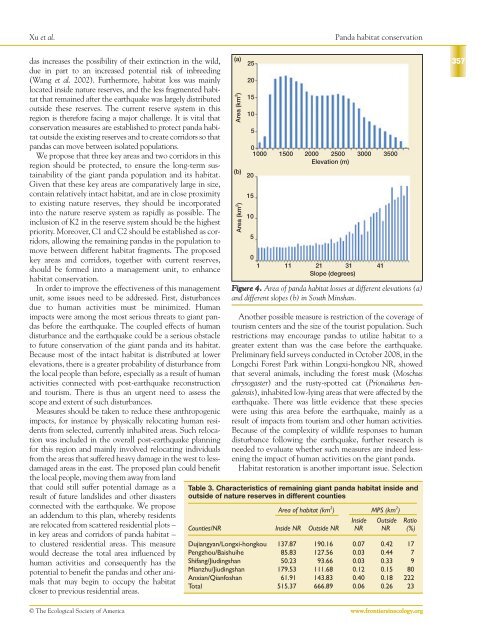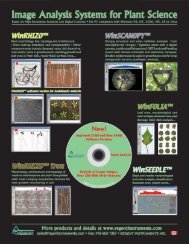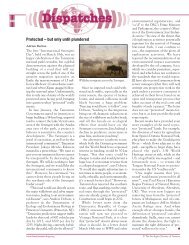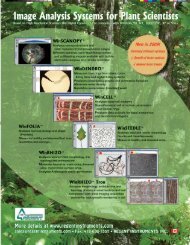Conservation of giant panda habitat in South Minshan, China, after ...
Conservation of giant panda habitat in South Minshan, China, after ...
Conservation of giant panda habitat in South Minshan, China, after ...
Create successful ePaper yourself
Turn your PDF publications into a flip-book with our unique Google optimized e-Paper software.
Xu et al.Panda <strong>habitat</strong> conservationdas <strong>in</strong>creases the possibility <strong>of</strong> their ext<strong>in</strong>ction <strong>in</strong> the wild,due <strong>in</strong> part to an <strong>in</strong>creased potential risk <strong>of</strong> <strong>in</strong>breed<strong>in</strong>g(Wang et al. 2002). Furthermore, <strong>habitat</strong> loss was ma<strong>in</strong>lylocated <strong>in</strong>side nature reserves, and the less fragmented <strong>habitat</strong>that rema<strong>in</strong>ed <strong>after</strong> the earthquake was largely distributedoutside these reserves. The current reserve system <strong>in</strong> thisregion is therefore fac<strong>in</strong>g a major challenge. It is vital thatconservation measures are established to protect <strong>panda</strong> <strong>habitat</strong>outside the exist<strong>in</strong>g reserves and to create corridors so that<strong>panda</strong>s can move between isolated populations.We propose that three key areas and two corridors <strong>in</strong> thisregion should be protected, to ensure the long-term susta<strong>in</strong>ability<strong>of</strong> the <strong>giant</strong> <strong>panda</strong> population and its <strong>habitat</strong>.Given that these key areas are comparatively large <strong>in</strong> size,conta<strong>in</strong> relatively <strong>in</strong>tact <strong>habitat</strong>, and are <strong>in</strong> close proximityto exist<strong>in</strong>g nature reserves, they should be <strong>in</strong>corporated<strong>in</strong>to the nature reserve system as rapidly as possible. The<strong>in</strong>clusion <strong>of</strong> K2 <strong>in</strong> the reserve system should be the highestpriority. Moreover, C1 and C2 should be established as corridors,allow<strong>in</strong>g the rema<strong>in</strong><strong>in</strong>g <strong>panda</strong>s <strong>in</strong> the population tomove between different <strong>habitat</strong> fragments. The proposedkey areas and corridors, together with current reserves,should be formed <strong>in</strong>to a management unit, to enhance<strong>habitat</strong> conservation.In order to improve the effectiveness <strong>of</strong> this managementunit, some issues need to be addressed. First, disturbancesdue to human activities must be m<strong>in</strong>imized. Humanimpacts were among the most serious threats to <strong>giant</strong> <strong>panda</strong>sbefore the earthquake. The coupled effects <strong>of</strong> humandisturbance and the earthquake could be a serious obstacleto future conservation <strong>of</strong> the <strong>giant</strong> <strong>panda</strong> and its <strong>habitat</strong>.Because most <strong>of</strong> the <strong>in</strong>tact <strong>habitat</strong> is distributed at lowerelevations, there is a greater probability <strong>of</strong> disturbance fromthe local people than before, especially as a result <strong>of</strong> humanactivities connected with post-earthquake reconstructionand tourism. There is thus an urgent need to assess thescope and extent <strong>of</strong> such disturbances.Measures should be taken to reduce these anthropogenicimpacts, for <strong>in</strong>stance by physically relocat<strong>in</strong>g human residentsfrom selected, currently <strong>in</strong>habited areas. Such relocationwas <strong>in</strong>cluded <strong>in</strong> the overall post-earthquake plann<strong>in</strong>gfor this region and ma<strong>in</strong>ly <strong>in</strong>volved relocat<strong>in</strong>g <strong>in</strong>dividualsfrom the areas that suffered heavy damage <strong>in</strong> the west to lessdamagedareas <strong>in</strong> the east. The proposed plan could benefitthe local people, mov<strong>in</strong>g them away from landthat could still suffer potential damage as aresult <strong>of</strong> future landslides and other disastersconnected with the earthquake. We proposean addendum to this plan, whereby residentsare relocated from scattered residential plots –<strong>in</strong> key areas and corridors <strong>of</strong> <strong>panda</strong> <strong>habitat</strong> –to clustered residential areas. This measurewould decrease the total area <strong>in</strong>fluenced byhuman activities and consequently has thepotential to benefit the <strong>panda</strong>s and other animalsthat may beg<strong>in</strong> to occupy the <strong>habitat</strong>closer to previous residential areas.(a)Area (km 2 )(b)Area (km 2 )25201510501000 1500 2000 2500 3000 3500Elevation (m)201510501 11 21 31 41Slope (degrees)Figure 4. Area <strong>of</strong> <strong>panda</strong> <strong>habitat</strong> losses at different elevations (a)and different slopes (b) <strong>in</strong> <strong>South</strong> M<strong>in</strong>shan.Another possible measure is restriction <strong>of</strong> the coverage <strong>of</strong>tourism centers and the size <strong>of</strong> the tourist population. Suchrestrictions may encourage <strong>panda</strong>s to utilize <strong>habitat</strong> to agreater extent than was the case before the earthquake.Prelim<strong>in</strong>ary field surveys conducted <strong>in</strong> October 2008, <strong>in</strong> theLongchi Forest Park with<strong>in</strong> Longxi-hongkou NR, showedthat several animals, <strong>in</strong>clud<strong>in</strong>g the forest musk (Moschuschrysogaster) and the rusty-spotted cat (Prionailurus bengalensis),<strong>in</strong>habited low-ly<strong>in</strong>g areas that were affected by theearthquake. There was little evidence that these specieswere us<strong>in</strong>g this area before the earthquake, ma<strong>in</strong>ly as aresult <strong>of</strong> impacts from tourism and other human activities.Because <strong>of</strong> the complexity <strong>of</strong> wildlife responses to humandisturbance follow<strong>in</strong>g the earthquake, further research isneeded to evaluate whether such measures are <strong>in</strong>deed lessen<strong>in</strong>gthe impact <strong>of</strong> human activities on the <strong>giant</strong> <strong>panda</strong>.Habitat restoration is another important issue. SelectionTable 3. Characteristics <strong>of</strong> rema<strong>in</strong><strong>in</strong>g <strong>giant</strong> <strong>panda</strong> <strong>habitat</strong> <strong>in</strong>side andoutside <strong>of</strong> nature reserves <strong>in</strong> different countiesArea <strong>of</strong> <strong>habitat</strong> (km 2 ) MPS (km 2 )Inside Outside RatioCounties/NR Inside NR Outside NR NR NR (%)Dujiangyan/Longxi-hongkou 137.87 190.16 0.07 0.42 17Pengzhou/Baishuihe 85.83 127.56 0.03 0.44 7Shifang/Jiud<strong>in</strong>gshan 50.23 93.66 0.03 0.33 9Mianzhu/Jiud<strong>in</strong>gshan 179.53 111.68 0.12 0.15 80Anxian/Qianfoshan 61.91 143.83 0.40 0.18 222Total 515.37 666.89 0.06 0.26 23357© The Ecological Society <strong>of</strong> America www.frontiers<strong>in</strong>ecology.org









